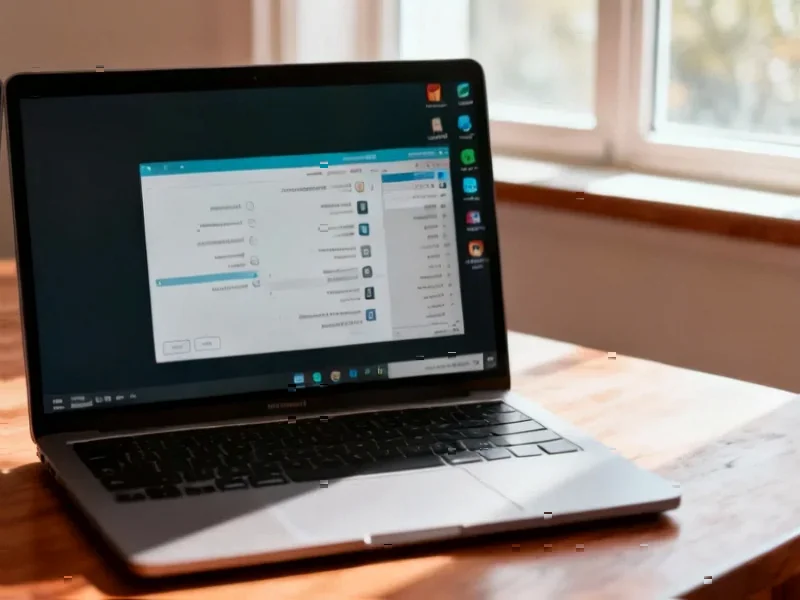According to TheRegister.com, System76’s COSMIC desktop environment will reach its stable 1.0 release alongside Pop!_OS 24.04 LTS on December 11, 2024, following three and a half years of development since the project’s 2021 announcement. CEO Carl Richell and developer Victoria Brekenfeld presented “Elevating The Linux Desktop with COSMIC DE” at the Ubuntu Summit, revealing that while HDR support and night light features won’t make the initial release, the desktop offers composable components, workspace management approaching GNOME parity, and selective COSMIC Sync for encrypted settings synchronization across distributions. The environment already runs on Fedora and Arch Linux, with testing showing impressive speed despite early instability in beta versions that was quickly resolved through updates. This represents a significant departure from traditional Linux desktop approaches that have dominated the landscape for decades.
The Rust Revolution Arrives in Desktop Computing
The decision to build COSMIC entirely in Rust represents one of the most ambitious bets in modern desktop computing. While Rust has gained significant traction in systems programming and web infrastructure, its application to full desktop environments has been limited. System76’s commitment demonstrates confidence in Rust’s memory safety guarantees and performance characteristics for graphical environments. This could trigger a broader industry shift away from C and C++ for desktop components, particularly as the composable architecture allows for incremental adoption. The timing is strategic – with major players like Microsoft exploring Rust for Windows components and Apple investing in memory-safe languages, COSMIC positions Linux at the forefront of this transition rather than playing catch-up.
Cross-Distribution Sync Changes the Game
COSMIC Sync represents perhaps the most underappreciated innovation in the announcement. The ability to synchronize settings, applications, and even Git repositories across different Linux distributions addresses a fundamental pain point that has plagued Linux adoption for years. The atomic sync mechanism – which rolls back incomplete synchronizations – shows sophisticated engineering thinking about real-world usage scenarios. More importantly, the “zero knowledge” architecture positions System76 as a privacy-first company in an era where user data protection has become a critical differentiator. As the synchronization features mature, we could see this becoming the standard for cross-device Linux experiences, potentially even influencing enterprise deployment strategies.
Challenging Two Decades of Desktop Stagnation
The Register’s observation that most modern desktop environments are essentially “re-implementations of existing designs” highlights a critical industry problem. Since Windows 95 established the basic desktop metaphor, innovation has largely been incremental rather than transformative. COSMIC’s composable approach – allowing users to choose between panel/dock configurations and even mimic other OS layouts – represents genuine innovation in user experience design. The ability to have horizontal panels on one display and vertical docks on another, as mentioned in testing, solves real multi-monitor workflow problems that GNOME and others have struggled with for years. This flexibility could make COSMIC particularly attractive for power users and developers who frequently work with complex display setups.
The Accessibility Roadmap Matters
While version 1.0 won’t include all planned accessibility features, the explicit commitment to screen magnification, color management, and reduced animation effects signals maturity in design thinking. Many new desktop environments treat accessibility as an afterthought, but System76 appears to be building it into their development roadmap from the beginning. As the development presentations indicate, this forward-thinking approach could give COSMIC significant advantages in enterprise and education markets where accessibility compliance is mandatory rather than optional. The delayed implementation of some features suggests careful prioritization rather than cutting corners – a refreshing approach in an industry often driven by artificial deadlines.
Market Implications and Distribution Strategy
The decision to make COSMIC available across multiple distributions from launch represents a strategic masterstroke. Unlike Canonical’s Unity, which remained Ubuntu-exclusive for years, System76 is embracing the broader Linux ecosystem immediately. This could accelerate adoption and community contributions while reducing the resource burden on a single company. The potential for an official Ubuntu flavor with COSMIC by the 26.10 release cycle, as speculated, would represent a significant endorsement and could position COSMIC as a genuine alternative to GNOME in the Ubuntu ecosystem. The cross-distribution compatibility also creates interesting possibilities for hardware vendors beyond System76 who want to offer customized Linux experiences without building entire desktop environments from scratch.
The 2026 Landscape: COSMIC’s Make-or-Break Year
Looking toward 2026, COSMIC faces both enormous opportunity and significant challenges. The desktop environment market has historically been difficult to penetrate, with most users sticking to default options. However, the combination of Rust’s technical advantages, genuine innovation in user experience, and strategic cross-distribution support creates a compelling package. The biggest test will be community adoption beyond System76’s existing Pop!_OS user base. If COSMIC can establish itself as the preferred environment for developers and power users on Arch and Fedora, it could trigger a virtuous cycle of contributions and improvements. The missing HDR and night light features in 1.0 need to arrive promptly in subsequent releases to maintain momentum, but the foundation appears solid for what could become the most significant new Linux desktop environment since GNOME 3.




